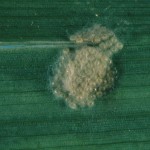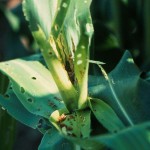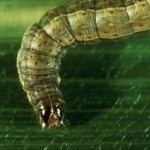Nineteen sites reporting this week with only two sites reporting European corn borer (ECB)-E and five with ECB-Z. Five sites caught one corn earworm (CEW) each, this is below the level for a recommended spray. Fall armyworm (FAW) catches were up this week with eight sites reporting trap catches and with one site as high as 13. Western bean cutworm (WBC) was caught at five sites this week.
Fall army worm numbers are up this week. When scouting sweet corn look for FAW egg masses on the leaves. Egg masses consist of 50-150 eggs and can be distinguished from ECB by the fine hairs covering the egg mass. Feeding damage is also very different from ECB. FAW will cause ragged feeding damage on leaves with large amounts of frass below the feeding site. The larva has a distinct inverted ‘Y’ on the front of the head.
- Fall armyworm egg mass.
- Fall armyworm damage
- Fall armyworm larva, note the inverted ‘Y’ om head capsule.
| Location | ECB-E | ECB-Z | CEW | FAW | WBC | DD to date |
| Avoca (Steuben Co.) | 0 | 0 | 0 | 0 | 0 | 1164 |
| Avon (Livingston Co.) | 0 | 0 | 1 | 1 | 0 | 1324 |
| Baldwinsville (Onondaga Co.) | 0 | 1 | 0 | 1 | 0 | 1336 |
| Batavia (Genesee Co.) | NA | NA | NA | NA | NA | 1042 |
| Bellona (Yates Co.) | 0 | 5 | 0 | 3 | 0 | 1379 |
| Eden (Erie Co.) | 0 | 0 | 0 | 4 | 0 | 1252 |
| Farmington (Ontario Co.) | 0 | 0 | 0 | 0 | 0 | 1264 |
| Hamlin (Monroe Co.) | NA | NA | NA | NA | NA | 1238 |
| Kennedy (Chautauqua Co.) | 0 | 0 | 0 | 2 | 4 | 1067 |
| King Ferry (Cayuga Co.) | NA | NA | NA | NA | NA | 1298 |
| Kirkville (Madison Co.) | 0 | 0 | 0 | 1 | 0 | 1394 |
| LeRoy (Genesee Co.) | NA | NA | NA | NA | NA | 1146 |
| Lockport (Niagra Co.) | 0 | 4 | 1 | 1 | NA | 1170 |
| Oswego (Oswego Co.) | 0 | 0 | 0 | 0 | 1 | 1218 |
| Owego (Tioga Co.) | 0 | 0 | 0 | 0 | 0 | 1176 |
| Pavilion (Genesee Co.) | 0 | 0 | 1 | 13 | 2 | 1147 |
| Penn Yan (Yates Co.) | 0 | 0 | 0 | 0 | 0 | 1339 |
| Plessis (Jefferson Co.) | 0 | 0 | 0 | 0 | 2 | 1149 |
| Preble (Cortland Co.) | 0 | 0 | 0 | 0 | 0 | 1294 |
| Seneca Castle (Ontario Co.) | 0 | 0 | 0 | 0 | 0 | 1271 |
| Sherwood (Cayuga Co.) | NA | NA | NA | NA | NA | 1298 |
| Spencerport (Monroe Co.) | 1 | 4 | 1 | 0 | 0 | 1324 |
| Waterport (Orleans Co.) | 0 | 0 | 1 | 0 | 0 | 1238 |
| Williamson (Wayne Co.) | 1 | 1 | 0 | 0 | 1 | 1176 |
| ECB – European Corn Borer CEW – Corn Earworm FAW – Fall Armyworm WBC – Western Bean Cutworm NA – not available DD – Degree Day (modified base 50F) accumulation |
||||||
| trap catches for the week of 7.8.14 – 7.15.14 |
||||||
I have included the accumulated degree days (modified base 50F) for each trap location based on the nearest weather station. The second flight of ECB begins around 1400 degree days. We are still on average 150 degree days from the second generation ECB flight, but some sites could see the second flight begin within the next week. Below is a table showing the estimated development of the bivoltine ECB.




